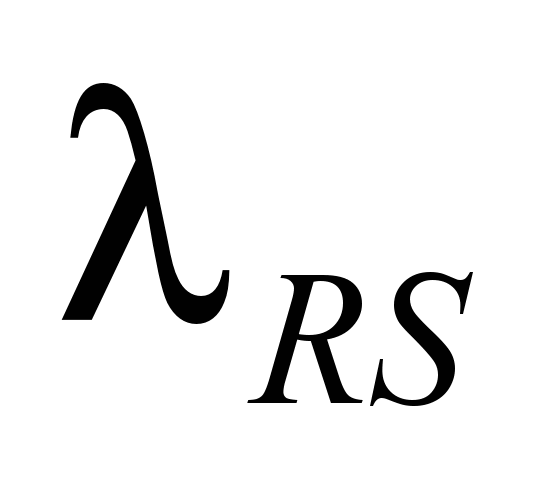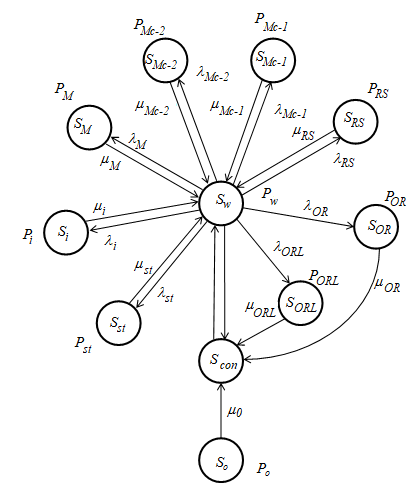ISSN
2307–3489 (Print), ІSSN
2307–6666
(Online)
Наука
та прогрес транспорту. Вісник
Дніпропетровського
національного університету залізничного
транспорту, 2018, № 4
(76)
рухомий
склад залізниць і тяга поїздів
UDC
629.463.083-049.6
V.
Y. SHAPOSHNYK1*
1*Dep.
«Cars and Cars Facilities», Dnipropetrovsk National University of
Railway Transport named after Academician
V. Lazaryan, Lazaryan
St., 2, Dnipro, Ukraine, 49010, tel. +38 (056) 373 15 19,
e-mail
vladislav.sh91@gmail.com, ORCID 0000-0003-4701-6491
THEORETICAL
STUDIES ON THE
PROCESS OF CHANGE
OF THE TECHNICAL CONDITion
OF Freight CARS
IN OPERATION
Purpose.
The scientific work is intended to investigate the technical
condition of freight cars during their operation. The said purpose
involves solving the following tasks: 1) to describe the technical
condition of a freight car during the maintenance and repair period;
2) to determine the dependences of the probability of a freight car
being in working condition during the life cycle; 3) to specify the
expression for the technical availability ratio of the car fleet.
Methodology.
To achieve the purpose, the author examined the methodological
approaches to the definition of various stages of the freight car
life cycle. The system of change and transition of the technical
condition of the freight car is described using differential
equations. Findings.
In the case of an unstable process of changing the technical
condition of a freight car, the probabilistic characteristic of the
appropriate life cycle stage depends on the amount of time. The
intensity of the input and output flows are correlated with each
other, taking into account the probability of a freight car being at
the appropriate stage of its life cycle. Originality.
Transitions from one car life cycle to another occur in
discrete steps, that is, such transitions are characterized by a
random process. The probability of a
freight car being at the appropriate life cycle is determined by its
prior technical condition. The total value of the set of all possible
conditions consists of the Markov chain for random processes with
random states and a continuous flow of time. The study resulted in
obtaining, for the first time, of the dependence of the probability
of a freight car being in working condition during the life
cycle. Practical value.
On the basis of the obtained definition for the probability of
the freight car being in working condition the expression for the
technical availability ratio of the car fleet was clarified.
Keywords:
freight car; reliability; life cycle of the car; technical condition
diagram; technical availability ratio;
car fleet
Introduction
The main task of rail transport
is to ensure uninterrupted transportation process, the mandatory
condition of which is the safe railway operation [9, 17]. Successful
implementation of the tasks facing the railway needs to improve the
technical level of rolling stock, the introduction of modern
high-efficient constructive solutions, materials and technologies
[12, 16, 18, 19]. In order to maintain a high technical level of
the car fleet, it is necessary to introduce the modern technologies
for renewal and increase of wear resistance of parts, improvement of
the maintenance system of cars in operation [4, 8, 10, 13, 15]. With
the introduction of new information technologies that enable the
automatic identification of cars and their individual parts, even
the normal operation of the car can be viewed as a stand for
reliability testing [6, 11]. The analysis of publications on this
problem indicates the need for theoretical studies of the process of
changing the technical condition of freight cars in operation [1, 7,
14].
Purpose
The main purpose of the work is
to investigate the process of changing the technical condition of
freight cars in operation. To achieve it, it is necessary: 1) to
describe the technical condition of the freight car during
maintenance and repair; 2) to determine the dependences of the
probability of a freight car being in working condition during the
life cycle; 3) to specify the expression for the technical
availability ratio of the car fleet.
Methodology
The
freight car
during its
lifetime may
be at
different stages
of the
life cycle:
– in
the initial
state (test
sample, which
undergoes
acceptance tests
and has
a trial
run);
– in
under-control operation;
– in
good working condition;
– on
maintenance (M,
Mc-1, Mc-2);
– on
roundhouse servicing (RS);
– on
overall repairs (OR, OR with life extension);
– on
storage;
– in
a good non-working condition (idle).
Transitions
from one life cycle to another occur in discrete steps, that is,
such transitions are characterized by a random process [2]. The
probability of a freight car being at the appropriate life cycle is
determined by its prior technical condition. The total value of the
set of all possible conditions consists of the Markov chain for
random processes with random states and a continuous flow of time.
In this case, there is a sequence of dependent technical states [3].
The transition itself from one technical states
 to other
to other
 occurs through the actions of the
corresponding streams of events. Such events are failure or
restoration.
occurs through the actions of the
corresponding streams of events. Such events are failure or
restoration.
Let us denote
the failure flow intensity rate as
 ,
and the restoration flow intensity rate of
the technical condition of the freight car as
,
and the restoration flow intensity rate of
the technical condition of the freight car as
 .
.
Characteristics of the
corresponding technical condition of the freight car at a certain
stage of the life cycle are given in Table 1.
Table
1
Characteristics
of the technical condition of the freight car during the life cycle
|
Stage
of the relevant life cycle
|
Designation
of technical condition,

|
Failure
intensity value, λ
|
Restoration
intensity rate of the technical condition,
μ
|
|
Starting
(initial) state
|

|
-
|
-
|
|
Under-control
operation
|

|
-
|

|
|
Good
working condition
|

|
-
|
-
|
|
On
maintenance
|

|

|

|
|
On
maintenance Mc-1
|

|

|

|
|
On
maintenance Mc-2
|

|

|

|
|
On
roundhouse servicing
|

|

|

|
|
On
OR
|

|

|

|
|
On
OR with life extension
|

|

|

|
|
On
storage
|

|

|

|
|
Idle
state
|

|

|

|
For the given technical
conditions of the life cycle of a freight car it is possible to
propose
a marked diagram with corresponding transitions (Fig.
1).
The indication of the technical
condition of the freight car is given in the circles, and the
transitions themselves from one condition to another are indicated
by arrows specifying the intensity of the failure or restoration
flows. Each technical condition of the freight car is characterized
by the corresponding probability:
–  – probability
rate of
freight car
being in
its original
condition (a
test specimen
undergoing
acceptance tests
and having
a trial
run);
– probability
rate of
freight car
being in
its original
condition (a
test specimen
undergoing
acceptance tests
and having
a trial
run);
–  – probability
rate of
freight car
being in
working
condition;
– probability
rate of
freight car
being in
working
condition;
–  – probability
rate of carrying out maintenance of the freight car;
– probability
rate of carrying out maintenance of the freight car;
–  – probability
rate of carrying Mc-1 of the freight car;
– probability
rate of carrying Mc-1 of the freight car;
–  – probability rate of carrying Mc-2 of
the freight car;
– probability rate of carrying Mc-2 of
the freight car;
–  – probability
rate of being under the control of operation;
– probability
rate of being under the control of operation;
–  – probability
rate of conducting RS of the freight car;
– probability
rate of conducting RS of the freight car;
–  – probability
rate of carrying out OR of the freight car;
– probability
rate of carrying out OR of the freight car;
–  – probability
rate of carrying out ORL of the freight car;
– probability
rate of carrying out ORL of the freight car;
–  – probability
rate of the working condition of the freight car during storage;
– probability
rate of the working condition of the freight car during storage;
–  – probability
rate of the working condition of the freight car at idle.
– probability
rate of the working condition of the freight car at idle.
The
probability flow of the technical condition of the freight car will
be equal to the product:
 .
.

Fig.
1. Freight car technical condition diagram
Findings
In the case of an unstable
process of changing the technical condition of a freight car, the
probabilistic characteristic of the appropriate life cycle stage
depends on the amount of time, while the intensity of the input and
output flows are correlated with each other, taking into account the
probability of a freight car being at the appropriate stage of its
life cycle.
The
very system
of change
and transition
of the
technical
condition of
the freight
car according
to the
diagram (Fig.
1) can be
described by
means of
differential
equations [3,
5]:
 ; (1)
; (1)
 ; (2)
; (2)
 ; (3)
; (3)
 ; (4)
; (4)
 ; (5)
; (5)
 ; (6)
; (6)

 ; (7)
; (7)

 ; (8)
; (8)
 ; (9)
; (9)
 ; (10)
; (10)
For
the probability
of freight
car being
in working
condition, we
use the
following
differential
equation:




 (11)
(11)
If
we
solve
the
system
of
equations
(1-11), we
can
find
the
probability
of
the
freight
car being
in
working
condition
(12):
Using
the expression
to find
the probability
of the
freight car being in
the working
condition (12),
we can
clarify for
the expression for the technical availability ratio of the car fleet
(13):
where
 – the number
of freight
cars in
good technical
condition;
– the number
of freight
cars in
good technical
condition;
 –
the corresponding freight car;
–
the corresponding freight car;
 – total
number
of
the
car
fleet
units.
– total
number
of
the
car
fleet
units.
Originality
and practical
value
Having formed the Markov chain
for random processes of probability of the freight car being at a
corresponding life cycle with random conditions and continuous flow
of time, we for the first time obtained dependence of probability of
the freight car being in the working condition during the life
cycle. On the basis of the obtained definition for the probability
of the freight car being in working condition the expression for the
technical availability ratio of the car fleet was clarified.
Conclusions
The work considered change of
technical condition of freight cars in operation occurs during the
whole lifetime, and the technical condition can be in different
stages of the life cycle. Transitions from one car life cycle to
another occur in discrete steps, that is, such transitions are
characterized by a random process.
LIST OF REFERENCE LINKS
Босов,
А. А. Теоритические основы рационального
содержания подвижного состава железных
дорог : монография / А.
А.
Босов, П. А.
Лоза. – Днепропетровск : Дриант, 2015. –
252 с.
Бочаров,
П. П. Теория вероятностей. Математическая
статистика / П. П. Бочаров, А. В. Печинкин.
– Москва : Физматлит, 2005. – 296 с.
Булинский,
А. В. Теория случайных процессов / А. В.
Булинский, А. Н. Ширяев. – Москва :
Физматлит, 2005. – 408 с.
Дюргеров,
Н. Г. Восстановление и повышение
износостойкости деталей вагонов :
учеб. пособие для вузов ж.-д. трансп. /
Н. Г. Дюргеров, И. С. Морозкин, В. Н. Кротов.
– Ростов н/Д, 2011. – 255 с.
Корн,
Г. Справочник по математике для
научных работников и инженеров.
Определения,
теоремы, формулы : [пер.
с англ.] / Г. Корн, Т. Корн. –
Москва : Наука, 1974. – 832 с.
Мурадян,
Л. А.
Автоматична
ідентифікація
окремих
частин
транспортного
засобу
при впроваджені нових
концепцій
системи
технічного
обслуговування
та ремонту
/ Л. А. Мурадян, В. Ю. Шапошник //
Інформ.-керуючі
системи
на залізн. трансп.
–
2017. –
№
4.
–
С. 44–50.
Мурадян,
Л. А. Методологические основы
определения эксплуатационных
характеристик несамоходного подвижного
состава / Л. А. Мурадян, В. Ю. Шапошник,
А. А. Мищенко // Наука та прогрес
транспорту. – 2016. – № 1 (61).
– С. 169–179. doi:
10.15802/stp2016/61044
Мурадян,
Л. А.
Повышение надежности грузовых вагонов
с применением новых технологий
изготовления и восстановления рабочих
поверхностей / Л. А. Мурадян, В. Ю.
Шапошник, Д. А. Подосенов
// Електромагнітна
сумісність та безпека на залізничному
транспорті. – 2016. – №
11. – С. 49–54.
Мямлин, В.
В. Теоретические основы создания гибких
поточных производств для ремонта
подвижного состава
: монография / В. В.
Мямлин. – Днепропетровск : Стандарт-Сервис,
2014. – 380 с.
Мямлин, С.
В. Определение стратегии технического
обслуживания и ремонта вагонной техники
/
С. В. Мямлин, Л. А.
Мурадян, В. Ю. Шапошник // Транспортная
инфраструктура Сибирского региона
:
материалы
VII-ой междунар.
науч.-техн. конф.
(29
марта – 1
апр. 2016
г.).
– Иркутск, 2016. –
Т.
2. – С. 369–373.
Мямлін,
С. В.
Проблема
визначення
терміну
«надійність».
Методологія
побудови
та вивчення
надійності
вантажних
вагонів
/ С. В. Мямлін, Л. А. Мурадян, Д. М.
Барановський // Наука та прогрес
транспорту.
– 2015. –
№
6 (60).
–
С. 110–117. doi:
10.15802/stp2015/57034
Остаточный
срок службы детали и алгоритм управления
фактическим состоянием грузового
вагона с учётом требуемого уровня
риска возникновения опасного отказа
/ П. А. Устич, А. А. Иванов,
Ф. А.
Мажидов, А. А. Салтыкова // News
of science :
Proceedings of
materials the
international scientific
conference
(Czech Republic,
Karlovy Vary ;
Russia, Moscow,
30–31 August 2015). – Karlovy
Vary ; Kirov,
2015. – С. 83–94.
Рейдемейстер,
А. Г. Способы увеличения прочности
боковых рам трехэлементных тележек /
А. Г. Рейдемейстер, А. А. Шикунов // Наука
та прогрес транспорту. – 2015.
– № 5 (59). – С. 141–149.
doi:
10.15802/stp2015/55351
Устич,
П. А. Надежность
рельсового нетягового подвижного
состава / П.
А.
Устич,
В.
А.
Карпычев,
М.
Н.
Овечников.
– Москва
: УМЦ МПС, 2004. – 416 с.
Fomin,
O. V. Improvement of upper bunding of side wall of gondola cars of
12-9745 model / O. V. Fomin
// Metallurgical and Mining Industry. – 2015. – Vol.
7, No. 1. – P. 45–48.
Myamlin,
S. V.
The modeling
of economic
efficiency
of products
carriage-building
plant
in conditions
of dynamic
pricing
/ S. V. Myamlin, D. Baranovskiy // Проблеми
економіки
транспорту
:
зб.
наук.
пр.
Днiпропетр.
нац. ун-ту залізн. трансп. iм.
акад. В. Лазаряна.
–
Дніпропетровськ,
2014. –
Вип. 7.
– С. 61–66.
doi:
10.15802/pte.v0i7.32096
Pradhan,
S. Application of Semi-Hertzian
Approach to Predict the Dynamic Behavior of Railway Vehicles
Through a Wear Evolution Model /
Smitirupa Pradhan, Arun Kumar Samantaray,
Ranjan Bhattacharyya / Journal
of Friction and Wear. – 2017. – Vol. 38. – Iss.
6. – P. 437–443. doi: 10.3103/s1068366617060125
Shykunov,
O. A. Three-element bogie side frame strength
/
О.
А.
Shykunov
// Наука
та прогрес транспорту.
– 2017. – № 1 (67).
– С.
183–193.
doi:
10.15802/stp2017/92535
Zhao,
F. Influence of small stress cycles on the fatigue damage of C70E
car body
/
F. Zhao, J. Xie // Journal
of Mechanical Engineering. – 2014. – Vol. 50. – Iss. 10. –
P. 121–126. doi: 10.3901/jme.2014.10.121
В.
Ю. ШАПОШНИК1*
1*Каф.
«Вагони та вагонне господарство»,
Дніпропетровський національний
університет залізничного транспорту
імені академіка В. Лазаряна, вул.
Лазаряна, 2, Дніпро, Україна, 49010, тел.
+38 (056) 373 15 19,
ел. пошта vladislav.sh91@gmail.com,
ORCID 0000-0003-4701-649
ТЕОРЕТИЧНІ
ДОСЛІДЖЕННЯ ПРОЦЕСУ ЗМІНИ ТЕХНІЧНОГО
СТАНУ ВАНТАЖНИХ ВАГОНІВ під час
ЕКСПЛУАТАЦІЇ
Мета.
У науковій роботі необхідно дослідити
технічний стан вантажних вагонів під
час їх експлуатації. Зазначена мета
передбачає розв’язання таких завдань:
1) описати технічний стан вантажного
вагона в період технічного обслуговування
й ремонту; 2) з’ясувати залежності
ймовірності перебування вантажного
вагона в робочому стані протягом циклу
існування; 3) уточнити вираз для
коефіцієнта технічної готовності
вагонного парку. Методика.
Для досягнення поставленої мети автором
були розглянуті методологічні підходи
до визначення різних стадій життєвого
циклу вантажного вагона. Система зміни
й переходу технічного стану вантажного
вагона описана за допомогою диференціальних
рівнянь. Результати.
У випадку неусталеного процесу зміни
технічного стану вантажного вагона
ймовірнісна характеристика відповідної
стадії життєвого циклу залежить від
величини часу. Інтенсивність вхідного
й вихідного потоків корелюються між
собою
з урахуванням імовірності
перебування вантажного вагона на
відповідній стадії його життєвого
циклу.
Наукова новизна.
Переходи з одного життєвого циклу
вагона в інший відбуваються стрибкоподібно,
тобто таким переходам властивий
випадковий процес. Імовірність
перебування вантажного вагона у
відповідному життєвому циклі визначається
його попереднім технічним станом.
Загальна величина сукупності всіх
можливих станів складається з ланцюга
Маркова для випадкових процесів із
випадковими станами й безперервним
потоком часу. У результаті дослідження
вперше отримана залежність імовірності
перебування вантажного вагона в робочому
стані протягом циклу існування. Практична
значимість. На основі
отриманого визначення для ймовірності
перебування вантажного вагона в робочому
стані було уточнено вираз для коефіцієнта
технічної готовності вагонного парку.
Ключові
слова:
вантажний вагон; надійність; життєвий
цикл вагона; схема
технічного стану;
коефіцієнт технічної готовності;
вагонний парк
В.
Ю. ШАПОШНИК1*
1*Каф.
«Вагоны и вагонное хозяйство»,
Днепропетровский национальный
университет железнодорожного транспорта
имени академика В. Лазаряна, ул. Лазаряна,
2, Днипро, Украина, 49010, тел. +38 (056) 373 15 19,
эл. почта vladislav.sh91@gmail.com, ORCID
0000-0003-4701-6491
ТЕОРЕТИЧЕСКИЕ
ИССЛЕДОВАНИЯ ПРОЦЕССА ИЗМЕНЕНИЯ
ТЕХНИЧЕСКОГО СОСТОЯНИЯ ГРУЗОВЫХ ВАГОНОВ
при ЭКСПЛУАТАЦИИ
Цель.
В научной работе необходимо исследовать
техническое состояние грузовых вагонов
при их эксплуатации. Указанная цель
предполагает решение следующих задач:
1) описать техническое состояние
грузового вагона в период технического
обслуживания и ремонта; 2) выяснить
зависимости вероятности нахождения
грузового вагона в рабочем состоянии
в течение цикла существования; 3) уточнить
выражение для коэффициента технической
готовности вагонного парка. Методика.
Для достижения поставленной цели
автором были рассмотрены методологические
подходы к определению различных стадий
жизненного цикла грузового вагона.
Система изменения и перехода технического
состояния грузового вагона описана с
помощью дифференциальных уравнений.
Результаты.
В случае неустановившегося процесса
изменения технического состояния
грузового вагона вероятностная
характеристика соответствующей стадии
жизненного цикла зависит от величины
времени. Интенсивность входного и
выходного потоков коррелируются между
собой с учетом вероятности пребывания
грузового вагона на соответствующей
стадии его жизненного цикла.
Научная новизна.
Переходы с одного жизненного цикла
вагона в другой происходят скачкообразно,
то есть таким переходам присущий
случайный процесс. Вероятность нахождения
грузового вагона в соответствующем
жизненном цикле определяется его
предыдущим техническим состоянием.
Общая величина совокупности всех
возможных состояний состоит из цепи
Маркова для случайных процессов со
случайными состояниями и непрерывным
потоком времени. В результате исследования
впервые получена зависимость вероятности
пребывания грузового вагона в рабочем
состоянии в течение цикла существования.
Практическая
значимость. На основе
полученного определения вероятности
нахождения грузового вагона в рабочем
состоянии было уточнено выражение для
коэффициента технической готовности
вагонного парка.
Ключевые
слова: грузовой вагон; надежность;
жизненный цикл вагона; схема технического
состояния; коэффициент технической
готовности; вагонный парк
REFERENCES
Bosov,
A. A., & Loza, P. A. (2015). Teoriticheskie
osnovy ratsionalnogo soderzhaniya podvizhnogo sostava zheleznykh
dorog: Monografiya. Dnepropetrovsk:
Driant. (in
Russian)
Bocharov,
P. P., &
Pechinkin,
A. V. (2005).
Teoriya veroyatnostey.
Matematicheskaya statistika. Moscow:
Fizmatlit. (in
Russian)
Bulinskiy,
A. V., & Shiryaev, A. N. (2005).
Teoriya sluchaynykh protsessov.
Moscow: Fizmatlit. (in
Russian)
Dyurgerov,
N. G., Morozkin, I. S., & Krotov, V. N. (2011).
Vosstanovlenie i povyshenie
iznosostoykosti detaley vagonov: Uchebnoe posobie dlya vuzov
zheleznodorozhnogo transporta.
Rostov-on-Don. (in
Russian)
Korn,
G., & Korn, T. (1974). Spravochnik
po matematike dlya nauchnykh rabotnikov i inzhenerov: Opredeleniya,
teoremy, formuly. Perevod
s angliyskogo. Moscow: Nauka. (in
Russian)
Muradyan,
L. A., &
Shaposhnik, V.
Yu. (2017).
Automatic identification of separate
parts of vehicle with iplementation of new concepts of maintenance
and repair implementation.
Informacijno-kerujuchi
systemy na zaliznychnomu transporti,
4, 44-50.
(in Ukranian)
Muradyan,
L. A., Shaposhnik, V. Yu., & Mishchenko, A. A. (2016).
Methodological fundamentals of
determination of unpowered rolling stock maintenance
characteristics. Science
and Transport Progress, 1(61),
169-179. doi:
10.15802/stp2016/61044 (in
Russian)
Muradyan,
L. A., Shaposhnik, V. Yu., & Podosenov, D. A. (2016).
Improving
the reliability of freight wagons with the use of new manufacturing
technologies and regeneration of working surfaces.
Electromagnetic compatibility and
safety on railway transport, 11,
49-54. (in
Russian)
Myamlin,
V. V. (2014).
Teoreticheskie osnovy sozdaniya
gibkikh potochnykh proizvodstv dlya remonta podvizhno-go sostava:
Monografiya.
Dnepropetrovsk: Standart-Servis.
(in Russian)
Myamlin,
S. V., Muradyan, L. A., & Shaposhnik, V. Yu. (2016).
Opredelenie strategii tekhnicheskogo obsluzhivaniya i remonta
vagonnoy tekhniki.
Transportnaya infrastruktura
Sibirskogo regiona:
Materialy VII-oy Mezhdunar nauchno-tekhnicheskoy konferentsii
(Irkutsk, 29 march–1 april ),
2,
369-373. (in
Russian)
Myamlіn,
S. V., Muradyan,
L. A., & Baranovskiy,
D. M. (2015).
Problem of the definition the
«reliability» term. Methodology of construction and study the
reliability of freight cars. Science
and Transport Progress, 6(60),
110-117. doi: 10.15802/stp2015/57034
(in Ukranian)
Ustich,
P. A., Ivanov,
A. A.,
Mazhidov, F.
A., &
Saltykova, A.
A. (2015).
Ostatochnyy srok sluzhby detali i algoritm upravleniya fakticheskim
sostoyaniem gruzovogo vagona s uchetom trebuemogo urovnya riska
vozniknoveniya opasnogo otkaza. News
of
science:
Proceedings
of
materials
the
international
scientific
conference
(Czech
Republic,
Karlovy
Vary
; Russia,
Moscow,
30–31 August
), 83–94.
(in
Russian)
Reydemeyster,
A. G., & Shikunov,
A. A. (2015).
Strength increase methods of the side
frame of the bogie in three–piece trucks.
Science and Transport Progress, 5(59),
141-149. doi: 10.15802/stp2015/55351 (in
Russian)
Ustich,
P. A., &
Karpychev, V.
A., &
Ovechnikov, M.
N. (2004).
Nadezhnost relsovogo netyagovogo
podvizhnogo sostava. Moscow: UMTs
MPS. (in
Russian)
Fomin,
O. V. (2015). Improvement of upper bunding of side wall of gondola
cars of 12-9745 model. Metallurgical
and Mining Industry, 7(1),
45-48. (in English)
Myamlin,
S. V.,
& Baranovskiy,
D.
(2014).
The modeling
of economic
efficiency
of products
carriage-building
plant
in conditions
of dynamic
pricing.
The
Problems of the Transport Economics, 7,
61-66.
doi: 10.15802/pte.v0i7.32096
(in English)
Pradhan,
S. (2017). Application of
Semi-Hertzian Approach to Predict the Dynamic Behavior of Railway
Vehicles Through a Wear Evolution Model.
Smitirupa Pradhan, Arun Kumar Samantaray,
Ranjan Bhattacharyya. Journal
of Friction and Wear,
38(6), 437-443. doi:
10.3103/s1068366617060125
(in English)
Shykunov,
O. A. (2017). Three-element bogie side frame strength.
Science and Transport Progress,
1(67),
183-193.
doi:
10.15802/stp2017/92535 (in
English)
Zhao,
F., & Xie, J. (2014). Influence of small stress cycles on the
fatigue damage of C70E car body. Journal
of Mechanical Engineering, 50(10),
121-126. doi: 10.3901/jme.2014.10.121 (in
English)
Received:
March 29,
2018
Accepted:
July 11,
2018
d oi
10.15802/stp2018/ ©
V. Y. Shaposhnyk, 2018
oi
10.15802/stp2018/ ©
V. Y. Shaposhnyk, 2018
to other
occurs through the actions of the
corresponding streams of events. Such events are failure or
restoration.
,
and the restoration flow intensity rate of
the technical condition of the freight car as
.